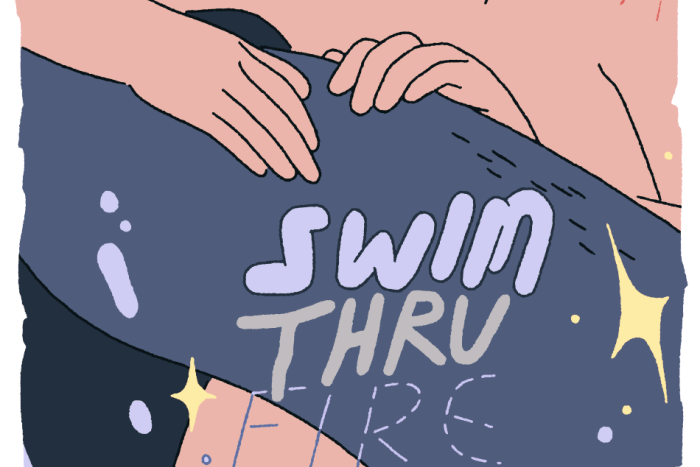I was twenty-two and rambling around the Maine coast when I found a copy of Loren Eiseley’s The Night Country in a Goodwill. It was a mass-market paperback with an emerald green cover: a silhouette of a man standing on a cliff looking into the night sky. I had never heard of Eiseley, but I connected with the image. I was lost. My boyfriend and I had made it to Maine on a freight train, in the backs of several strangers’ cars, and two Greyhounds. We were staying with his uncle in exchange for painting his house buttercup yellow. We were riding borrowed bicycles up and down the rocky hills looking for something to which to attach ourselves. My boyfriend was a recovering addict. I’d left college for inpatient rehab for anorexia. Two months later, we set out on this trip.
The Night Country is a collection of personal essays Eiseley published late in his career, just a few years before his death. It marked a bold turn in his life as a writer, away from academic writing, as he’d been criticized within the scientific community for his more poetic tendencies. An heir to Emerson and Thoreau, Eiseley was an anthropologist, nature writer, philosopher, and poet. He held many distinguished honors in his life, but his most important title was that of a writer. He came to science by literature and to literature by science. Hewrote with a human skull upon his desk. He was a contemplator of deep time, and about the history contained within artifacts. In what he came to call the “concealed essay,” he used his own life as an entry point to explore deeper scientific truths. The country of his book’s title is the dark landscape he traversed within himself when he stayed up late at night, his mind refusing to sleep. He was a tireless thinker.
Though he spent the later years of his life in Philadelphia, teaching at the University of Pennsylvania, he remained deeply connected with his roots in Nebraska. He grew up the only child in his house outside Lincoln, and spent many solipsistic days wandering the plains and caves around his home. His mother was deaf and his father was a traveling salesman and a Shakespearean actor. Following his father’s example, Eiseley turned to literature at a young age. It was a means of simultaneous connection and escape, and of self-education; he taught himself to think by immersing himself in ideas. As the poet Howard Nemerov wrote in a letter to Eiseley around the time of The Night Country’s publication,
Coleridge said somewhere that the ideas one thinks of are altogether less important than the ones one thinks with, and your way of dealing with the world is for me one of the ideas one hopes to learn to think with; you see time as directly as most of us see space.
I had come upon The Night Country at exactly the right time. My future was uncertain. I struggled to ascertain the truth about my past. I consumed Eiseley’s essays, found in this wandering scholar a kindred spirit. His untethered thinking—in the space of a page, his thoughts settle on subatomic particles and a great artist with equal rigor—lent my own anxious, adolescent searching a timeless sensibility. At the core of Eiseley’s thinking is the theory of evolution; Darwin’s works form an overarching metaphor for Eiseley. “Evolution is far more a part of the unrolling future than it is of the past,” Eiseley says, “for the past, being past, is determined and done.” This was comforting to me—my past was no longer my concern. My concern was only how the future would continue to transform me.
What I took away from Eiseley at the time of our first encounter was the idea that my life and my suffering didn’t matter. I mean to say this is a good thing—that my pain wasn’t special. I was one lowly link in the chainmail of agony that began with the first conscious prehuman thought—how freeing a concept!
Just as Maine began to grow cold, my boyfriend and I decided to head south again, and found the scrub corner of a South Portland train yard. Eiseley writes of his time riding rails in The Lost Notebooks of Loren Eiseley, selected, compiled, and introduced by his Charles Scribner’s Sons editor, Kenneth Heuer. Among the poems, jottings and drafts of essays and speeches, as well as letters Eiseley sent and received spanning his lifetime, is “The Mop to K.C.,” an early short fiction. A train-hopping narrator meets a young hobo on a “Mop,” possibly referring to a Missouri Pacific, or MoPac, train:
He kept getting up and looking out of the car till I figured he had the bull horrors. There were hollows under his eyes and he looked sick. He talked sometimes like he was a little off… The dirt was ground into him until not even an undertaker could get it off.
In Asheville the month before, we got drunk in the freight yard with a hobo named Bailey and her hobo boyfriend, Mission. We had met them the day before begging for change in a public park. Bailey was missing most of her teeth. They were both covered in stick-and-poke tattoos. At one point, Bailey produced a plastic bag containing, among other things, a used IV rig, which they both proceeded to use. After sitting in the yard overnight, and sleeping through one train, we gave up on waiting and decided to hitchhike. It wasn’t until we got to Pittsburgh without them that I realized they’d stolen my iPod.
In Pittsburgh, we sprang for a Motel 6. While my boyfriend slept, I wrote in my Moleskine a poem that I now don’t remember writing. The date is August 3. In the poem, I watch my boyfriend sleeping, and I say
there’s something beautiful
inside his skull
I know
something untouchable
something I can never hold
something raw like new skin
dragged along a gravel road
it will always smart
On the facing page, I find a photograph of my mother circa 1977. She is sitting in the bow of the sailboat she owned with my father before I was born. She wears a midriff linen shirt open at the collar, and turns her face toward the sun in calm ecstasy. This sailboat has hovered in the background of my childhood mythology as a vague, misdirected nostalgia, for as long as I can remember. I have always wished they hadn’t sold the boat. It feels real to me, like something I’ve lost.
Through Eiseley’s lens, I see the diary as an artifact. Its contents feel like missives from my past. “We uncover the bones of the past and seek for our origins,” Eiseley writes, but the path to our past is hard to locate. The road wanders, and the manner in which it wanders may have its own meaning. So we pause in an attempt to puzzle over its symbols, which prove to be inscrutable; the artifacts found alongside our path tell us nothing of where it goes. We want to determine how we came to the present, whether by destiny or choice. There isn’t an answer. The arrow of time rushes forward, into the future. “It is concerned with becoming, never with the past; it is always just leaving the present, and the present is briefly, very briefly, ourselves.”
Between the pages of this notebook, I find black and white photographs of a mysterious coastline taken from the bulwark of an unseen ship. I find a Post-It note left on my refrigerator by a couple of fellow travelers who slept on our couch, on their way to the next place; an unsent postcard addressed to another Sarah, with a quote from Octavio Paz:
To us, the value of a work lies in its newness; the invention of new forms, or a novel combination of old forms, the discovery of unknown worlds or the exploration of unfamiliar areas in worlds already discovered—revelations, surprises.
On the next page, a picture my boyfriend took, with a disposable camera, from those two weeks in Maine. I am walking on a muddy beach dotted with oysters, water in the background. On another page, a strip of film bearing a ghostlike image of Bailey and her dog, standing on the edge of another body of water.
“How fast life flows from one form to another,” Eiseley says. Before he died, he asked his wife, Mabel, to burn his notebooks. It’s possible he worried his writings would seem outdated, or like the artifacts he left in the form of jottings would be indecipherable to future generations. Needless to say, Mabel didn’t burn them. After his death, Heuer prepared three of Eiseley’s manuscripts for posthumous publication. Then, with archivists, and Mabel’s permission, he began to compile Eiseley’s notebooks. It took four years of intermitted “detective work,” he says. In the end, rather than organize the entries by subject, he ordered them chronologically—to reveal Eiseley’s evolution as a writer and thinker. In the last pages, Eiseley jots down notes for his autobiography, beginning with a scene of train-hopping hobos. They die like birds in the cold, he says. It was the Great Depression, a time of sacrifice and love. “It was all that every human generation believes it has encountered for the first time,” he says. “Life is always a journey and a death or many deaths. Mine was no different from those others.”
What I took away from Eiseley at the time of our first encounter was the idea that my life and my suffering didn’t matter. I mean to say this is a good thing—that my pain wasn’t special. I was one lowly link in the chainmail of agony that began with the first conscious prehuman thought—how freeing a concept! I could feel and feel. This feeling had come before me and would come after, too. Man has been wandering all this time. “We will never be permitted to glimpse the thoughts of the first dawning human brain as it mourned above its dead and felt itself surrounded by a vast inimical universe indifferent to its agonies,” Eiseley says, and we needn’t want to. We feel what he feels. Time would swallow my suffering. Or it already had. I’d already survived it.
Like Eiseley’s, my heart doesn’t know where to settle. I get attached to things, and people, and stories. This summer, I went with my husband to the beach at Fort Tilden. I found a rusty piece of metal buried in the sand. I picked it up, turned it over in the sun. Its shape was vaguely that of Florida, my home. Its sudden transition from metal to rust, from smooth to rough, I found entrancing. With Eiseley, the magic of science is preserved; is intrinsic to scientific pursuit, and to life. I keep the metal now on a shelf by my pillow. I wonder about its past in the moments before sleep. Maybe it’s trash from some long-ago construction. Maybe it fell from someone’s truck. Maybe it traveled a long distance.
Paper Trail is a monthly column exploring the relationship between artists and their journals.






